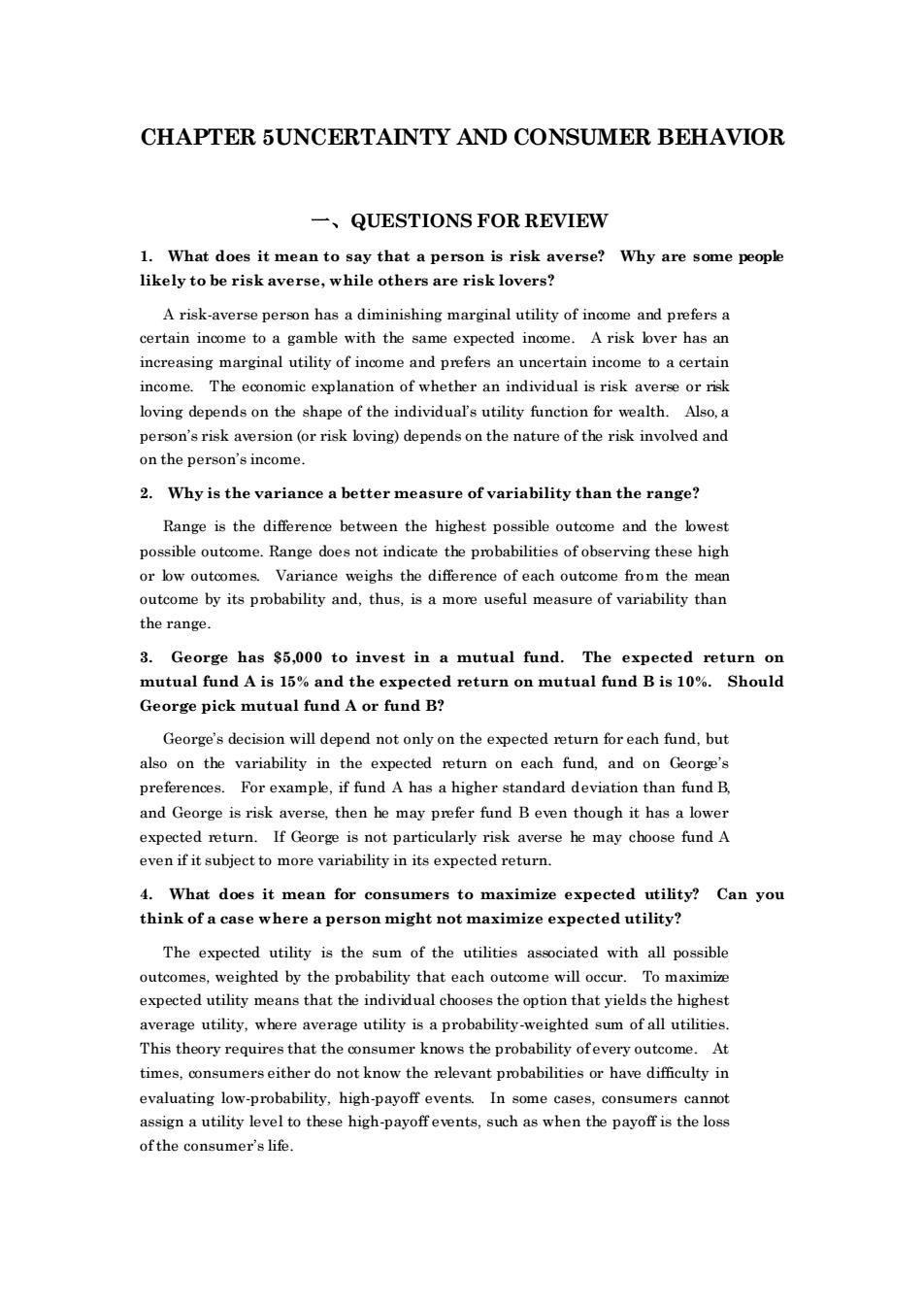
CHAPTER SUNCERTAINTY AND CONSUMER BEHAVIOR 一、QUESTIONS FOR REVIEW 1.What does it mean to say that a person is risk averse?Why are some people likely to be risk averse,while others are risk lovers? a risk-averse person has a diminishing marginal utility of income and prefers a certain income toa gamble with the same e A risk bver has income. The economic explanation of whether an individual is risk averse orrisk loving depends on the shape of the individual's utility function for wealth.Also,a person's risk aversion(or risk loving)depends on the nature of the risk involved and on the person's income. 2.Why is the variance a better measure of variability than the range? Range is the difere between the highest and thewe .Range does not indi cate the probabilities of observing these high or low outcomes. Variance weighs the difference of each outcome from the mean outcome by its probability and.thus,is a more useful measure of variability than the range 3.George has $5,000 to invest in a mutual fund.The expected return on mutual fund A is 15%and the expected return on mutual fund B is 10%.Should George pick mutual fund A or fund B? George's depend the fund,but also on the variability in the expected return on each fund,and on George' preferences.For example,if fund A has a higher standard deviation than fund B and George is risk averse.then he may prefer fund B even though it has a lower icularly risk averse he may chose fund A subject to more variability retur 4.What does it mean for consumers to maximize expected utility? Can you think of a case where a person might not maximize expected utility? The expected utility is the sum of the utilities associated with all possible outcomes,weighted by the probability that each outcome will occur.To maximize expected utility means that the individual chooses the option that yields the highest average utility.where average utility is a probability-weighted sum of all utilities. This theory require sthat the conumer knows the pro obability ofevero me, At times,onsumers either do not know the relevant probabilities or have difficulty in evaluating low-probability,high-payoff events.In some cases,consumers cannot assign a utility level to these high-payoff events,such as when the payoff is the loss of the consumer's life
CHAPTER 5UNCERTAINTY AND CONSUMER BEHAVIOR 一、QUESTIONS FOR REVIEW 1. What does it mean to say that a person is risk averse? Why are some people likely to be risk averse, while others are risk lovers? A risk-averse person has a diminishing marginal utility of income and prefers a certain income to a gamble with the same expected income. A risk lover has an increasing marginal utility of income and prefers an uncertain income to a certain income. The economic explanation of whether an individual is risk averse or risk loving depends on the shape of the individual’s utility function for wealth. Also, a person’s risk aversion (or risk loving) depends on the nature of the risk involved and on the person’s income. 2. Why is the variance a better measure of variability than the range? Range is the difference between the highest possible outcome and the lowest possible outcome. Range does not indicate the probabilities of observing these high or low outcomes. Variance weighs the difference of each outcome from the mean outcome by its probability and, thus, is a more useful measure of variability than the range. 3. George has $5,000 to invest in a mutual fund. The expected return on mutual fund A is 15% and the expected return on mutual fund B is 10%. Should George pick mutual fund A or fund B? George’s decision will depend not only on the expected return for each fund, but also on the variability in the expected return on each fund, and on George’s preferences. For example, if fund A has a higher standard deviation than fund B, and George is risk averse, then he may prefer fund B even though it has a lower expected return. If George is not particularly risk averse he may choose fund A even if it subject to more variability in its expected return. 4. What does it mean for consumers to maximize expected utility? Can you think of a case where a person might not maximize expected utility? The expected utility is the sum of the utilities associated with all possible outcomes, weighted by the probability that each outcome will occur. To maximize expected utility means that the individual chooses the option that yields the highest average utility, where average utility is a probability-weighted sum of all utilities. This theory requires that the consumer knows the probability of every outcome. At times, consumers either do not know the relevant probabilities or have difficulty in evaluating low-probability, high-payoff events. In some cases, consumers cannot assign a utility level to these high-payoff events, such as when the payoff is the loss of the consumer’s life
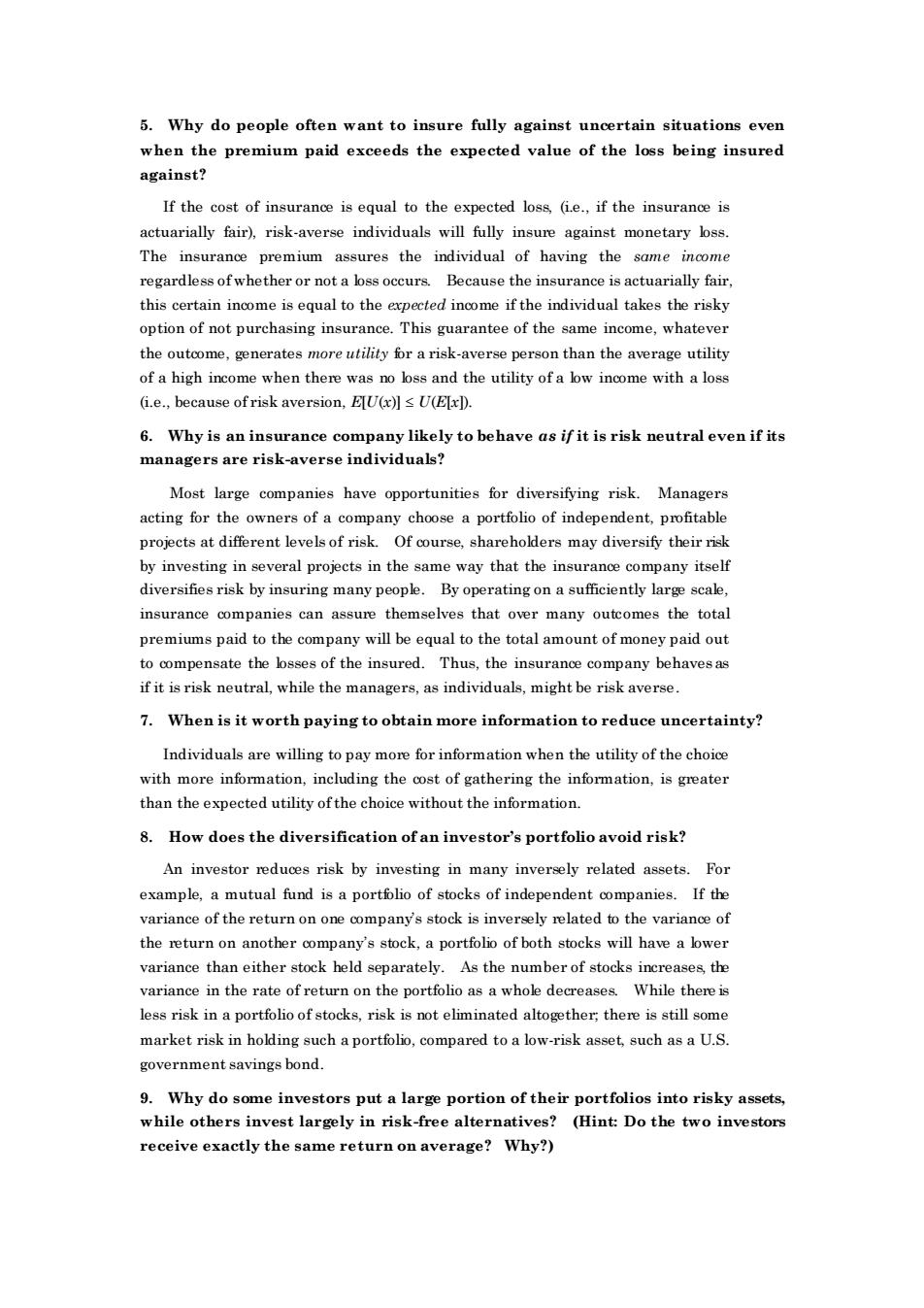
5.Why do people often want to insure fully against uncertain situations even when the premium paid exceeds the expected value of the loss being insured against. If the cost of insurance is equal to the expected loss (ie.if the insurance is actuarially fair).risk-averse individuals will fully insure against monetary bss. The insurance premium assures the individual of having the same income regardless ofwhether or not a bss occurs Because the insurance is actuarially fair. option of not purchasing insurance.This guarantee of the same income,whateve the outcome,generates more utility for a risk-averse person than the average utility of a high income when there was no loss and the utility of a low income with a loss (ie.because ofrisk aversion.ElU(x)I s U(EIxD). 6.Why is an insu rance con pany likely to behave as ifit is risk neutral even if its nagers are risk-averse individuals? Most large companies have oppe tu nities for diversifying risk.Manage acting for the owners of a company choose a portfolio of independent,profitabl projects at different levels of risk.Of course,shareholders may diversify their risk by investing in several projects in the same way that the insurance company itself diversifies risk by insuring many people.By operating on a sufficiently large scale. insurance companies can assure themselves that over many outcomes the total premiums paid to the company will be equal to the e total amount of me ney paid ou to compensate the losses of the insured.Thus,the insurance company behaves as if it is risk neutral,while the managers,as individuals,might be risk averse. 7.When is it worth paying to obtain more information to reduce uncertainty? Individuals are willing to pay more for information when the utility of the choice with more information.including the cost of gathering the information,is greater than the expected utility ofthe choice without the information 8.How does the diversification of an investor's portfolio avoid risk? An investor reduces risk by investing in many inversely related assets.For example a mutual fund is a portlio of stocks of independent ompanies.If th variance of the return on one company's stock is inversely related to the variance of the return on another company's stock.a portfolio of both stocks will have a lower variance than either stock held separately.As the number of stocks increases the variance in the rate of return on the portfolio as a whole decreases While there is less risk in a portfolio of stocks,risk is not eliminated altogether there market risk in holding such a portfolio,compared to a low-risk asset,such as a U.S government savings bond. 9.Why do some investors put a large portion of their portfolios into risky assets, while others invest largely in risk-free alternatives?(Hint:Do the two investors receive exactly the same return on average?why?)
5. Why do people often want to insure fully against uncertain situations even when the premium paid exceeds the expected value of the loss being insured against? If the cost of insurance is equal to the expected loss, (i.e., if the insurance is actuarially fair), risk-averse individuals will fully insure against monetary loss. The insurance premium assures the individual of having the same income regardless of whether or not a loss occurs. Because the insurance is actuarially fair, this certain income is equal to the expected income if the individual takes the risky option of not purchasing insurance. This guarantee of the same income, whatever the outcome, generates more utility for a risk-averse person than the average utility of a high income when there was no loss and the utility of a low income with a loss (i.e., because of risk aversion, E[U(x)] U(E[x]). 6. Why is an insurance company likely to behave as if it is risk neutral even if its managers are risk-averse individuals? Most large companies have opportunities for diversifying risk. Managers acting for the owners of a company choose a portfolio of independent, profitable projects at different levels of risk. Of course, shareholders may diversify their risk by investing in several projects in the same way that the insurance company itself diversifies risk by insuring many people. By operating on a sufficiently large scale, insurance companies can assure themselves that over many outcomes the total premiums paid to the company will be equal to the total amount of money paid out to compensate the losses of the insured. Thus, the insurance company behaves as if it is risk neutral, while the managers, as individuals, might be risk averse. 7. When is it worth paying to obtain more information to reduce uncertainty? Individuals are willing to pay more for information when the utility of the choice with more information, including the cost of gathering the information, is greater than the expected utility of the choice without the information. 8. How does the diversification of an investor’s portfolio avoid risk? An investor reduces risk by investing in many inversely related assets. For example, a mutual fund is a portfolio of stocks of independent companies. If the variance of the return on one company’s stock is inversely related to the variance of the return on another company’s stock, a portfolio of both stocks will have a lower variance than either stock held separately. As the number of stocks increases, the variance in the rate of return on the portfolio as a whole decreases. While there is less risk in a portfolio of stocks, risk is not eliminated altogether; there is still some market risk in holding such a portfolio, compared to a low-risk asset, such as a U.S. government savings bond. 9. Why do some investors put a large portion of their portfolios into risky assets, while others invest largely in risk-free alternatives? (Hint: Do the two investors receive exactly the same return on average? Why?)
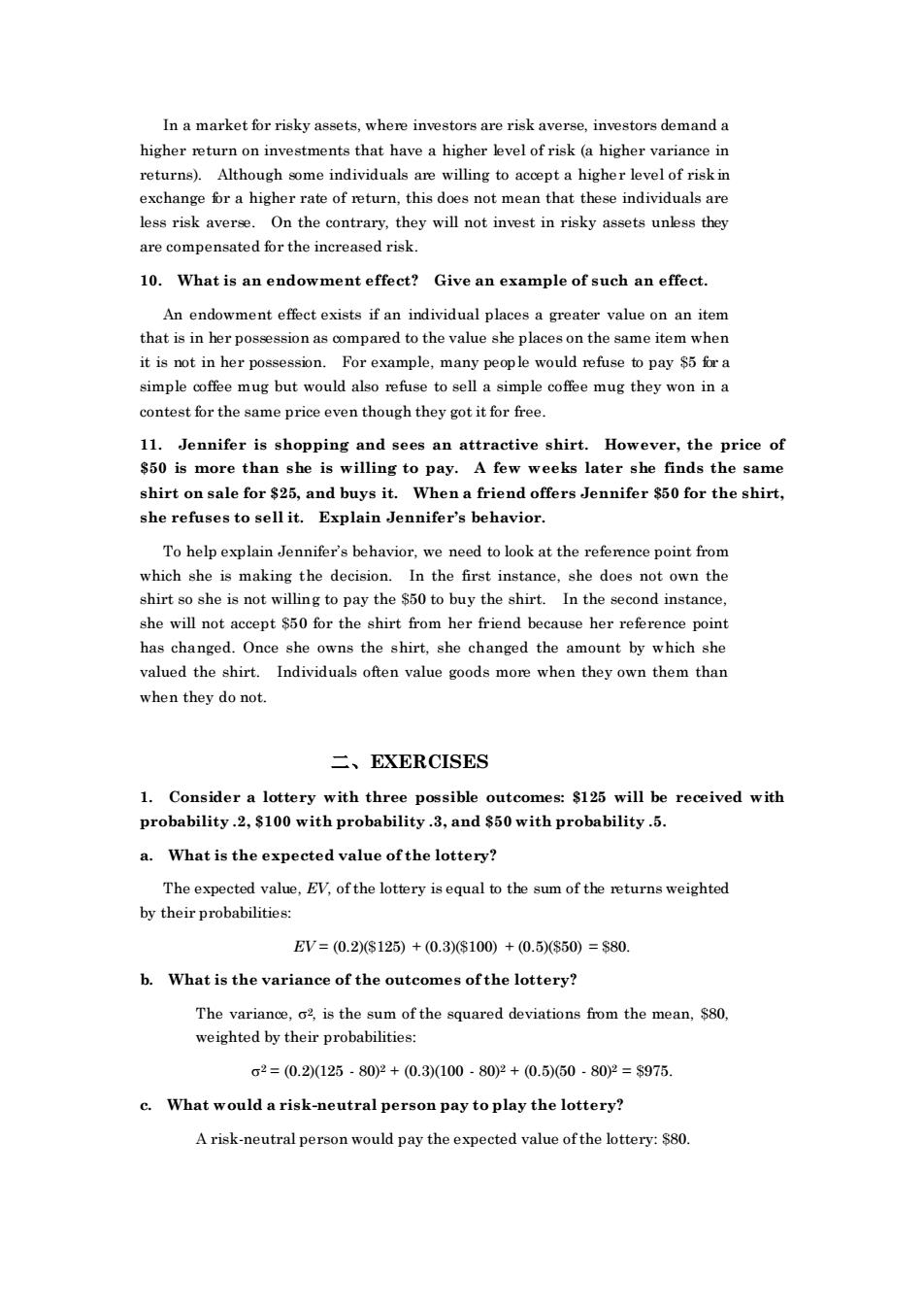
In a market for risky assets.where investors are risk averse,investors demand a on investments that have a higher evel of risk(a higher variance in returns). Although some individuals are willing to accept a higher level of risk in exchange for a higher rate of return,this does not mean that these individuals are less risk averse.On the contrary.they will not invest in risky assets unkess they are compensated for the increased risk. 10.What is an endowment effect?Give an example of such an effect. An endowment effect exists if an individual places a greater value on an item to the value she pac onthe same item when it is not in her or example,many people would refuse topay$5 simple coffee mug but would also refuse to sell a simple coffee mug they won in a contest for the same price even though they got it for free. 11.Jennifer is shopping and sees an attractive shirt.However,the price of $50 is more than she is willing to pay.A few weeks later she finds the same shirt on sale for $25,and buys it.When a friend offers Jennifer $50 for the shirt, she refuses to sell it. Explain Jennifer's behavior To help explain Jennifers behavior,we need to look at the reference point from which she is making the decision.In the first instance.she does not own the shirt so she is not willing to pay the $50 to buy the shirt.In the second instance. she will not accept $50 for the shirt from her friend because her reference point has changed.Once she owns the shirt.she changed the amount by which she valued the shirt.Individuals often value goods more when they own them than when they do not 二、EXERCISES 1.Consider a lottery with three possible outcomes:$125 will be received with probability.2,$100 with probability.3,and $50 with probability.5. a.What is the expected value ofthe lottery? The expected value,EV,of the lottery isequal to the sum of the returns weighted by their probabilities: EV=(0.2)$125)+(0.3)$100)+(0.5)$50)=$80 b.What is the variance of the outcomes ofthe lottery? The variance,is the sum of the squared deviations from the mean.$80. weighted by their probabilities 2=(0.2125.802+(0.3100.80+(0.560.80y=$975. c What would a risk-neutral person pay to play the lottery? Arisk-neutral person would pay the expected value ofthe lottery:$8
In a market for risky assets, where investors are risk averse, investors demand a higher return on investments that have a higher level of risk (a higher variance in returns). Although some individuals are willing to accept a higher level of risk in exchange for a higher rate of return, this does not mean that these individuals are less risk averse. On the contrary, they will not invest in risky assets unless they are compensated for the increased risk. 10. What is an endowment effect? Give an example of such an effect. An endowment effect exists if an individual places a greater value on an item that is in her possession as compared to the value she places on the same item when it is not in her possession. For example, many people would refuse to pay $5 for a simple coffee mug but would also refuse to sell a simple coffee mug they won in a contest for the same price even though they got it for free. 11. Jennifer is shopping and sees an attractive shirt. However, the price of $50 is more than she is willing to pay. A few weeks later she finds the same shirt on sale for $25, and buys it. When a friend offers Jennifer $50 for the shirt, she refuses to sell it. Explain Jennifer’s behavior. To help explain Jennifer’s behavior, we need to look at the reference point from which she is making the decision. In the first instance, she does not own the shirt so she is not willing to pay the $50 to buy the shirt. In the second instance, she will not accept $50 for the shirt from her friend because her reference point has changed. Once she owns the shirt, she changed the amount by which she valued the shirt. Individuals often value goods more when they own them than when they do not. 二、EXERCISES 1. Consider a lottery with three possible outcomes: $125 will be received with probability .2, $100 with probability .3, and $50 with probability .5. a. What is the expected value of the lottery? The expected value, EV, of the lottery is equal to the sum of the returns weighted by their probabilities: EV = (0.2)($125) + (0.3)($100) + (0.5)($50) = $80. b. What is the variance of the outcomes of the lottery? The variance, 2, is the sum of the squared deviations from the mean, $80, weighted by their probabilities: 2 = (0.2)(125 - 80)2 + (0.3)(100 - 80)2 + (0.5)(50 - 80)2 = $975. c. What would a risk-neutral person pay to play the lottery? A risk-neutral person would pay the expected value of the lottery: $80
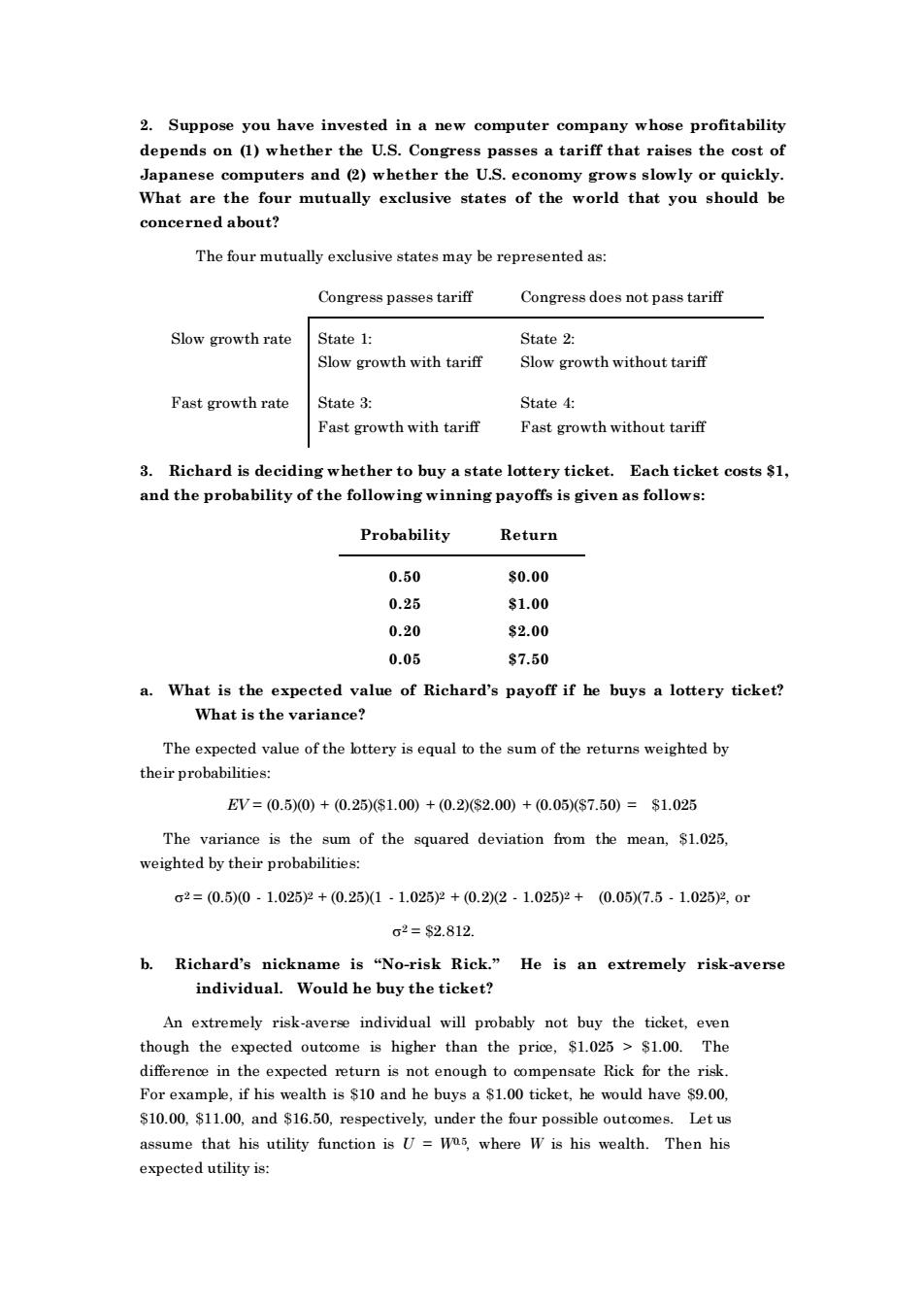
2.Suppose you have invested in a new computer company whose profitability depends on ()whether the U.S.Congress passes atarif that raises the Japanese computers and (2)whether the U.S.economy grows slowly or quickly What are the four mutually exclusive states of the world that you should be concerned about? The four mutually exclusive states may be represented as: Congress passes tariff Congress does not pass tariff Slow growth rate State 1: State 2: Slow growth with tariff Slow growth without tarif Fast growth rate State 3: State 4: ast growth with tariff Fast growth without tariff 3.Richard is deciding whether to buy astate lottery ticket.Each ticket costs$ and the probability of the following winning payoffs is given as follows: Probability Return 0.50 $0.00 0.25 $1.00 0.20 $2.00 0.05 $7.50 a.What is the expected value of Richard's payoff if he buys a lottery ticket? What is the variance? The expected value of the ttery isequal to the sum of by their probabilities EV=(0.50)+(0.25)s1.00)+(0.2(2.00)+(0.05)$7.50)=$1.025 The variance is the sum of the squared deviation from the mean,$1025 weighted by their probabilities: o2=(0.5)0·1.025)¥+(0.25(1·1.025)¥+(0.2(2·1.025)2+(0.05)(7.5-1.025)2.or o2=$2.812. b.Richard's nickname is "No-risk Rick."He is an extremely risk-averse individual.Would he buy the ticket? An extremely risk-averse individual will probably not buy the ticket,even though the expected outcome is higher than the price,$1025$1.00.The in the xpected Forexampk.ifh wl1oand be u0 ticket.be wuld have 59.0 ompens Rick for the risk $10.00,$11.00,and $16.50,respectively,under the four possible outcomes.Let us assume that his utility function is U=was,where W is his wealth.Then his expected utility is:
2. Suppose you have invested in a new computer company whose profitability depends on (1) whether the U.S. Congress passes a tariff that raises the cost of Japanese computers and (2) whether the U.S. economy grows slowly or quickly. What are the four mutually exclusive states of the world that you should be concerned about? The four mutually exclusive states may be represented as: Congress passes tariff Congress does not pass tariff Slow growth rate State 1: Slow growth with tariff State 2: Slow growth without tariff Fast growth rate State 3: Fast growth with tariff State 4: Fast growth without tariff 3. Richard is deciding whether to buy a state lottery ticket. Each ticket costs $1, and the probability of the following winning payoffs is given as follows: Probability Return 0.50 $0.00 0.25 $1.00 0.20 $2.00 0.05 $7.50 a. What is the expected value of Richard’s payoff if he buys a lottery ticket? What is the variance? The expected value of the lottery is equal to the sum of the returns weighted by their probabilities: EV = (0.5)(0) + (0.25)($1.00) + (0.2)($2.00) + (0.05)($7.50) = $1.025 The variance is the sum of the squared deviation from the mean, $1.025, weighted by their probabilities: 2 = (0.5)(0 - 1.025)2 + (0.25)(1 - 1.025)2 + (0.2)(2 - 1.025)2 + (0.05)(7.5 - 1.025)2, or 2 = $2.812. b. Richard’s nickname is “No-risk Rick.” He is an extremely risk-averse individual. Would he buy the ticket? An extremely risk-averse individual will probably not buy the ticket, even though the expected outcome is higher than the price, $1.025 > $1.00. The difference in the expected return is not enough to compensate Rick for the risk. For example, if his wealth is $10 and he buys a $1.00 ticket, he would have $9.00, $10.00, $11.00, and $16.50, respectively, under the four possible outcomes. Let us assume that his utility function is U = W0.5, where W is his wealth. Then his expected utility is:
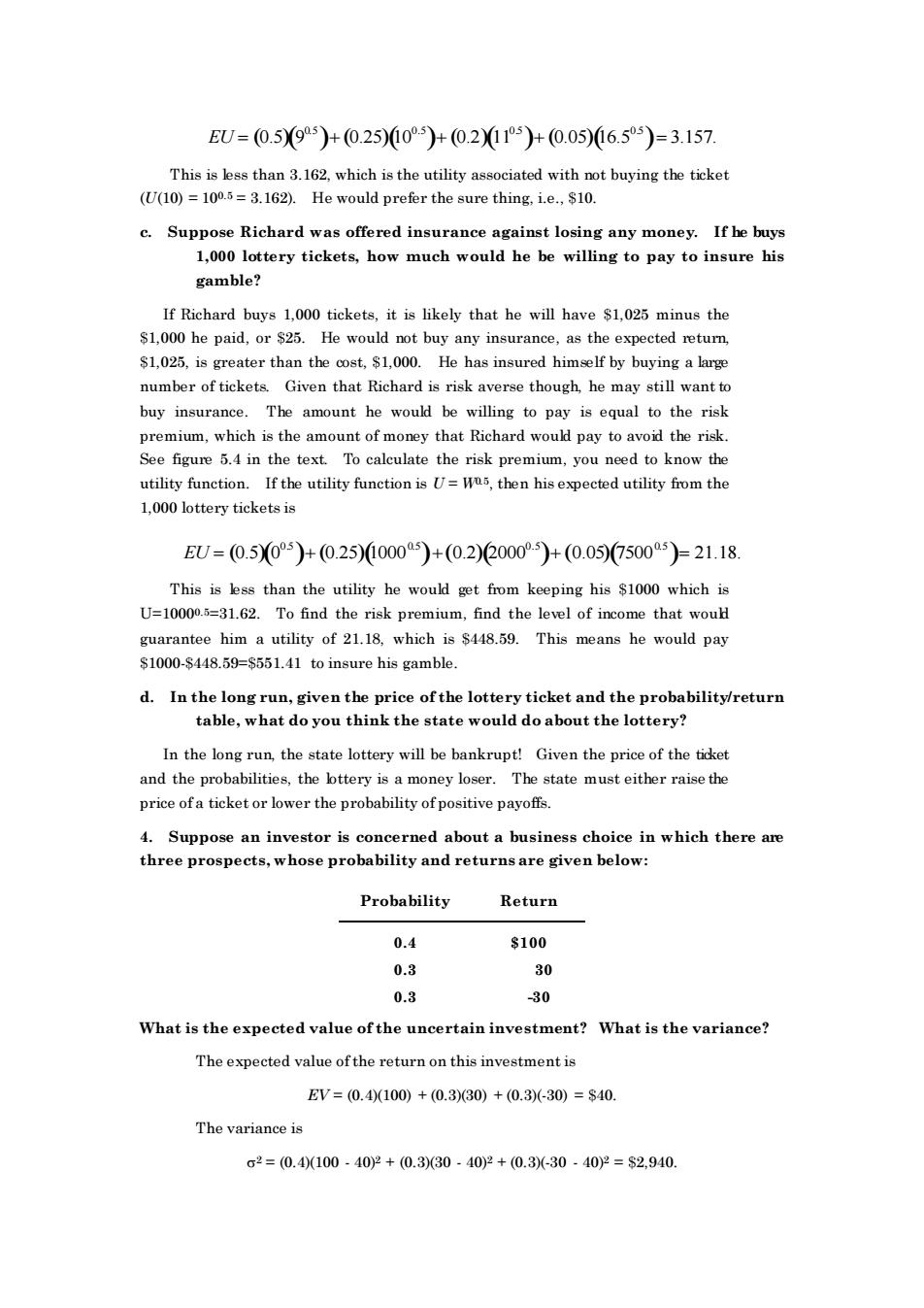
EU=(0.59s)+0.25)00+(0.21105)+(0.05)06.5)=3.157. c.Suppose Richard was offered insurance against losing any money.If he buys 1,000 lottery tickets,how much would he be willing to pay to insure his gamble? If Richard buys 1000 tickets.it is likely that he will have $1025 minus the the exp $1,025.is greater than the cost,00. elf by buy ng a larg number of tickets.Given that Richard is risk averse though,he may still want t buy insurance.The amount he would be willing to pay is equal to the risk premium,which is the amount of money that Richard would pay to avoid the risk. See figure 5.4 in the text To calculate the risk pr emium.you need to know the utility function.If the utility function isU=,then his expected utility from the EU=(0.50°5)+(0.25)00005)+(0.2)000°)+(0.0575005)21.18. This is less than the utility he would get from keeping his $1000 which is U=100005=31.62.To find the risk premium,find the level of income that woul d.In the long run,given the price ofthe lottery ticket and the probability/return table,what do you think the state would do about the lottery? In the long run,the state lottery will be bankrupt!Given the price of the ticket and the probabilities.the lottery is a money loser.The state must either raise the price of a ticket or lower the probability of positive payoff e an investor is concerned about a business choice in which there are e prosp ects,whose probability and returns are given below Probability Return 0.4 $100 .3 30 0.3 30 What is the expected value of the uncertain investment?What is the variance? The expected value of the return on this investment is EV=(0.4(100)+(0.330)+(0.3(-30)=$40 The variance is 2=(0.4100.40P+(0.330.40+0.3-30.40P=2,940
EU = (0.5) 9 0.5 ( )+ (0.25) 100.5 ( )+ (0.2) 110.5 ( )+ (0.05) 16.5 0.5 ( )= 3.157. This is less than 3.162, which is the utility associated with not buying the ticket (U(10) = 100.5 = 3.162). He would prefer the sure thing, i.e., $10. c. Suppose Richard was offered insurance against losing any money. If he buys 1,000 lottery tickets, how much would he be willing to pay to insure his gamble? If Richard buys 1,000 tickets, it is likely that he will have $1,025 minus the $1,000 he paid, or $25. He would not buy any insurance, as the expected return, $1,025, is greater than the cost, $1,000. He has insured himself by buying a large number of tickets. Given that Richard is risk averse though, he may still want to buy insurance. The amount he would be willing to pay is equal to the risk premium, which is the amount of money that Richard would pay to avoid the risk. See figure 5.4 in the text. To calculate the risk premium, you need to know the utility function. If the utility function is U = W0.5, then his expected utility from the 1,000 lottery tickets is EU = (0.5) 0 0.5 ( )+ (0.25) 10000.5 ( )+(0.2) 20000.5 ( )+ (0.05) 75000.5 ( )= 21.18. This is less than the utility he would get from keeping his $1000 which is U=10000.5=31.62. To find the risk premium, find the level of income that would guarantee him a utility of 21.18, which is $448.59. This means he would pay $1000-$448.59=$551.41 to insure his gamble. d. In the long run, given the price of the lottery ticket and the probability/return table, what do you think the state would do about the lottery? In the long run, the state lottery will be bankrupt! Given the price of the ticket and the probabilities, the lottery is a money loser. The state must either raise the price of a ticket or lower the probability of positive payoffs. 4. Suppose an investor is concerned about a business choice in which there are three prospects, whose probability and returns are given below: Probability Return 0.4 $100 0.3 30 0.3 -30 What is the expected value of the uncertain investment? What is the variance? The expected value of the return on this investment is EV = (0.4)(100) + (0.3)(30) + (0.3)(-30) = $40. The variance is 2 = (0.4)(100 - 40)2 + (0.3)(30 - 40)2 + (0.3)(-30 - 40)2 = $2,940